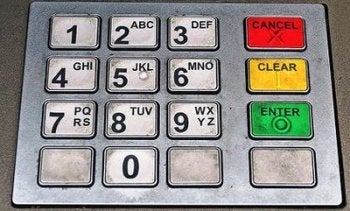Swab tests recently conducted of public surfaces in six major cities revealed that ATMs are among the worst carriers of illness-causing germs.
 The tests, conducted by Kimberly-Clark Corp. as part of its Healthy Workplace Project, showed that 41% of automated teller machine keypads carry germs that can cause colds and the flu. Kimberly-Clark is a maker of a wide variety of consumer products, including Kleenex tissues, waterless hand sanitizers and antibacterial hand soap.
The tests, conducted by Kimberly-Clark Corp. as part of its Healthy Workplace Project, showed that 41% of automated teller machine keypads carry germs that can cause colds and the flu. Kimberly-Clark is a maker of a wide variety of consumer products, including Kleenex tissues, waterless hand sanitizers and antibacterial hand soap.ATMs were No. 4 on the list of most-contaminated public surfaces, behind gas pump handles, 71% of which carry disease-causing germs, mailbox handles (68%) and escalator rails (43%).
The testing took place in Atlanta, Chicago, Dallas, Los Angeles, Miami and Philadelphia. About 350 samples were taken with swabs that were then tested for adenosine triphosphate (ATP), a naturally occurring chemical present in all animal, vegetable, bacteria, yeast and mold cells. Detection of ATP indicates the presence of contamination by any of these sources. Everyday objects with an ATP reading of 300 or higher are considered to have a high risk for illness transmission, according to Kimberly-Clark.
After ATM buttons, parking meters (40%), crosswalk buttons (35%) and vending machine buttons (35%) were the next most germ-laden public surfaces that people regularly touch.
"People do not realize the amount of contamination they are exposed to going to work each day and doing everyday things like filling their gas tank or riding on an escalator," Charles Gerba, a professor of microbiology at the University of Arizona, said in a statement. "This new testing is compelling because it underscores the importance of hand and surface hygiene. Most cold and flu viruses are spread because people touch surfaces in their immediate area and then touch their faces, other objects and other people."
Gerba recommends washing and thoroughly drying your hands throughout the day to minimize the risk of getting sick or spreading illness around an office.
Each year, companies lose $1,685 per employee due to absenteeism and "presenteeism" (the situation that arises when employees come to work even though they're sick and thereby spread their germs to their colleagues), according to the U.S. Centers for Disease Control and Prevention .
"The likelihood for illnesses to transfer from the objects that people use every day like ATMs and parking meters is eye-opening," said Brad Reynolds, marketing leaders of Kimberly-Clark's Healthy Workplace Project. "These findings indicate that illness-causing germs are everywhere and have the potential to travel with you into your office space. That's why we developed the Healthy Workplace Project -- a unique approach to hand and surface hygiene that helps employees understand and reduce the spread of cold and flu germs throughout their workplaces."
Kimberly-Clark's Healthy Workplace Project website provides educational materials that show how germs can be spread on public surfaces and stress the importance of washing your hands and keeping surfaces clean.




